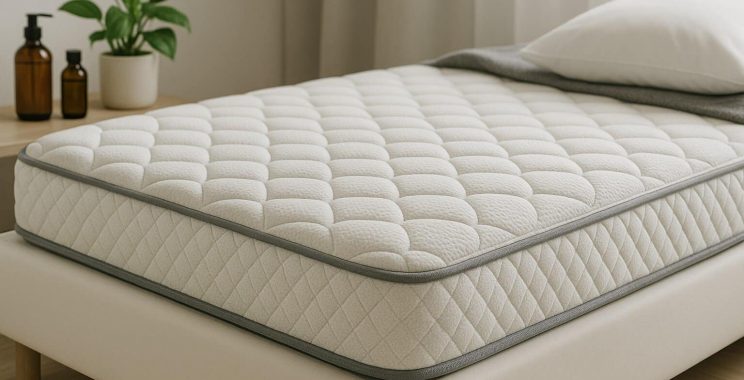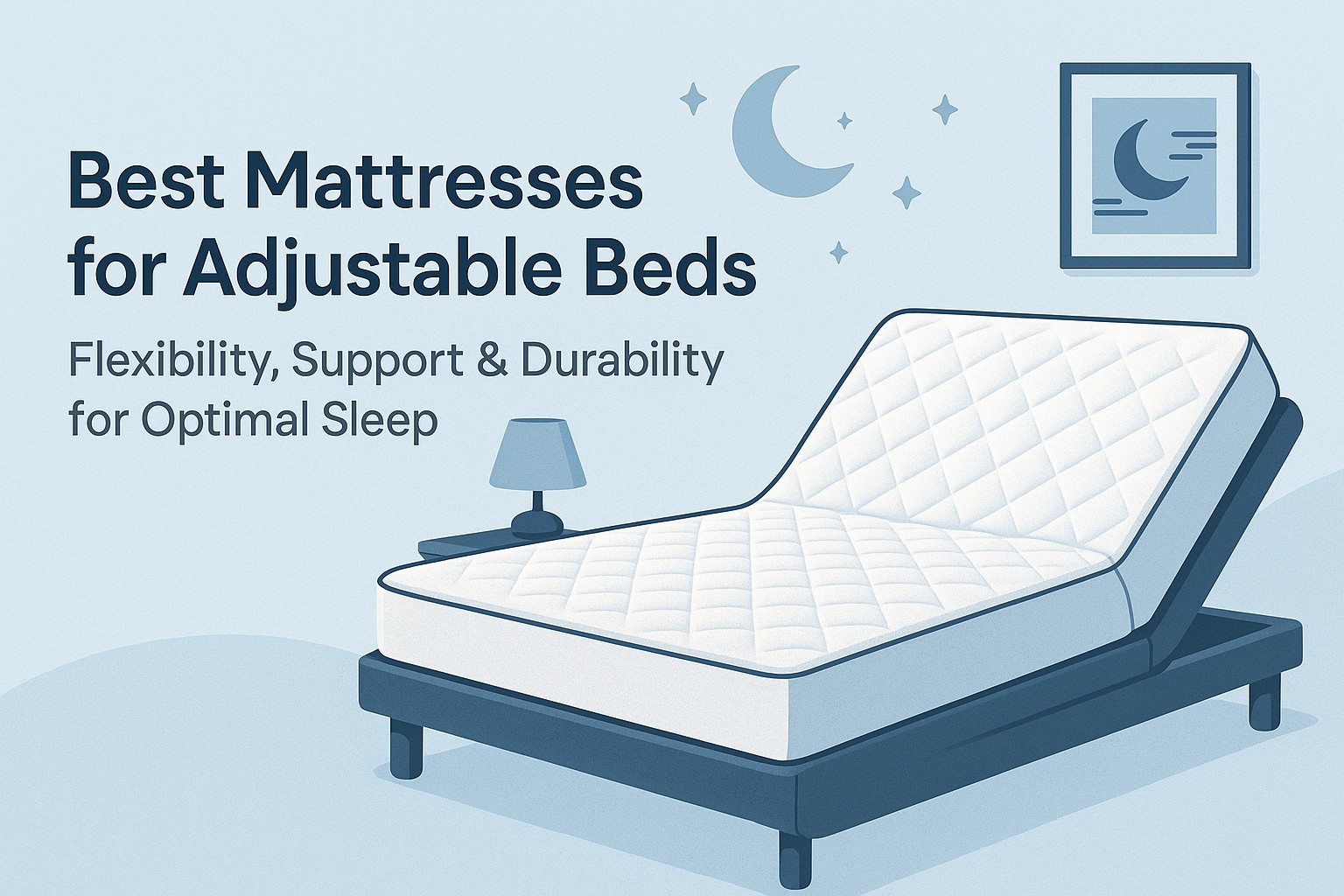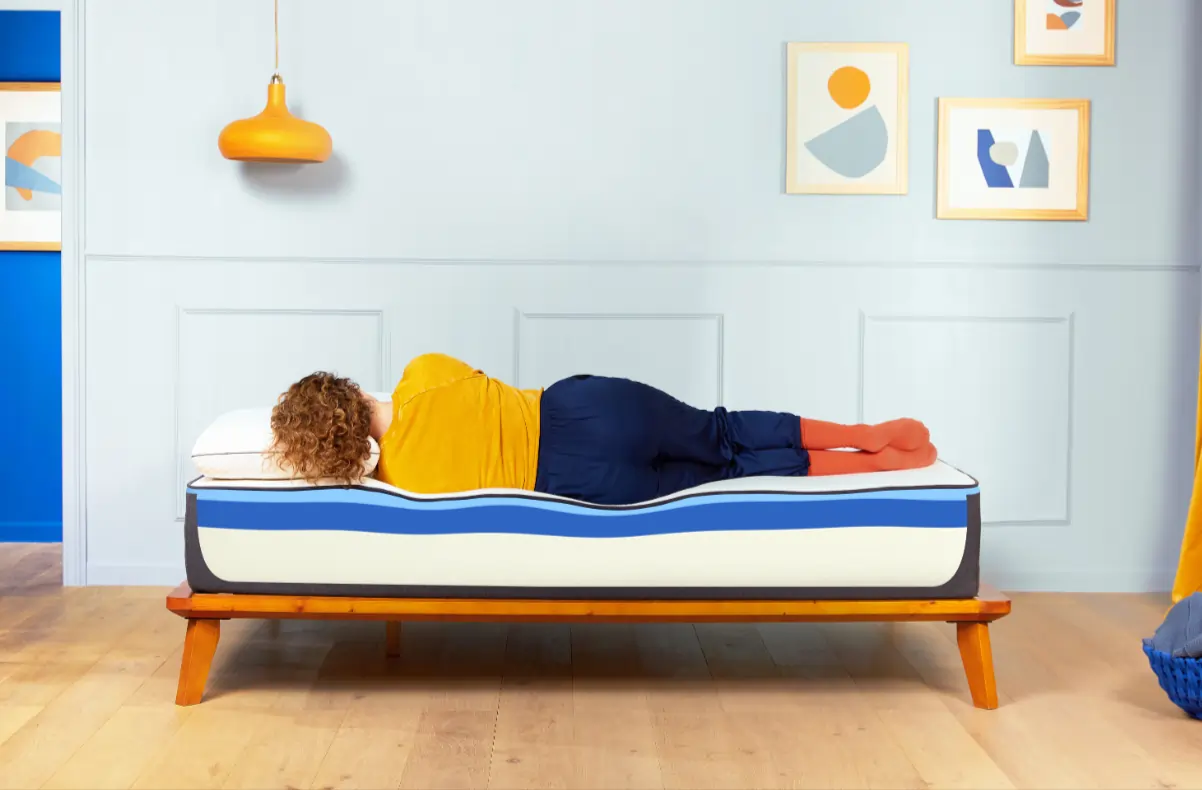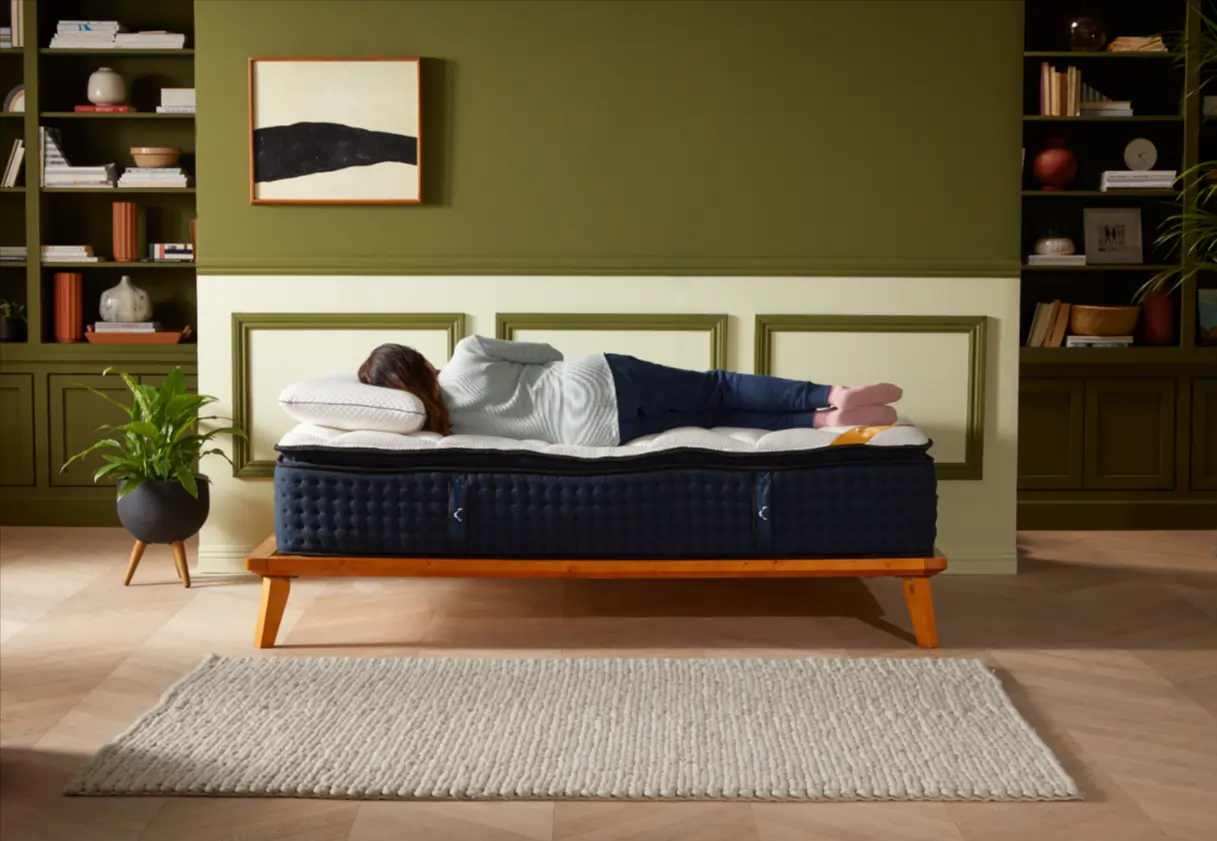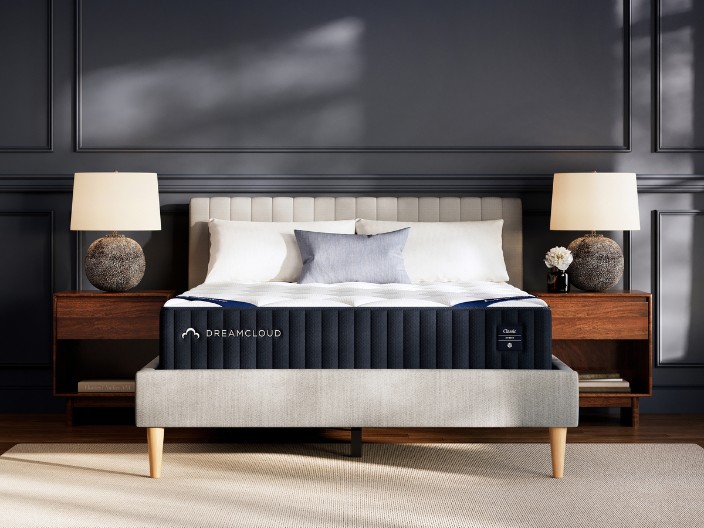Best Mattress for Allergies: Hypoallergenic Materials, Certifications, and Care for Allergy-Free Sleep
Share
Fact checked
Reviewed by experts
Updated
November 10, 2025
Quick read
8 mins to read
List of Content
If you’re among the 50 million Americans dealing with allergies, your mattress choice can significantly impact both your symptoms and sleep quality. The right hypoallergenic mattress creates a barrier against common allergens like dust mites, mold, and pet dander while providing the comfort and support you need for restorative sleep. Understanding which materials, certifications, and features to prioritize helps you find a mattress that minimizes allergic reactions while maximizing comfort.
Allergens in your sleep environment can trigger everything from mild congestion to severe respiratory symptoms, disrupting your sleep and affecting your daytime energy levels. Research published in the Journal of Allergy and Clinical Immunology shows that bedroom allergen exposure, particularly during the extended hours we spend sleeping, plays a crucial role in allergic sensitization and symptom severity. This makes selecting an allergy-friendly mattress more than just a comfort decision—it’s an investment in your overall health and well-being.
Understanding Mattress Allergies and Common Triggers
Mattress allergies stem from various sources, each requiring different mitigation strategies. Dust mites remain the most prevalent bedroom allergen, as these microscopic creatures thriving in warm, humid environments where they can feed on dead skin cells. A typical mattress can harbor anywhere from 100,000 to 10 million dust mites, according to research from the American College of Allergy, Asthma & Immunology. Their waste products, rather than the mites themselves, trigger allergic reactions including sneezing, runny nose, itchy eyes, and asthma symptoms.
Mold and mildew present another significant concern, particularly in humid climates or poorly ventilated bedrooms. These fungi can colonize mattresses that trap moisture, releasing spores that trigger respiratory symptoms and allergic reactions. Traditional innerspring mattresses with their hollow cores can provide ideal environments for mold growth when moisture accumulates, making material selection crucial for allergy sufferers in humid regions.
Chemical off-gassing from synthetic materials and adhesives creates additional challenges for sensitive individuals. Volatile organic compounds (VOCs) released from polyurethane foams, flame retardants, and manufacturing adhesives can trigger headaches, respiratory irritation, and allergic-type reactions. This is why certifications like CertiPUR-US, which ensures foams are made without harmful chemicals, become essential considerations when selecting a hypoallergenic mattress.
Natural latex allergies, while less common, require careful consideration when exploring mattress options. Approximately 1-2% of the population experiences latex sensitivity, with reactions ranging from mild skin irritation to severe respiratory symptoms. Understanding the difference between natural latex (derived from rubber tree sap) and synthetic latex helps inform safer choices for those with known sensitivities.
Key Features of the Best Hypoallergenic Mattresses
Truly hypoallergenic mattresses share several critical characteristics that work together to minimize allergen exposure. Material selection forms the foundation of any anti-allergen mattress strategy. Dense materials that resist allergen penetration, such as high-quality memory foam and certain natural materials, create inhospitable environments for dust mites and prevent the accumulation of pet dander and pollen.
Antimicrobial treatments represent another crucial defense against allergens. These treatments, applied to mattress covers and foam layers, inhibit the growth of bacteria, mold, and mildew that can trigger allergic reactions. For example, Nectar incorporates antimicrobial protection in their cooling top cover, creating an additional barrier against allergen accumulation while maintaining the breathability necessary for comfortable sleep.
Proper ventilation and moisture control prevent the humid conditions that dust mites and mold require to thrive. Modern hybrid mattresses achieve this through strategic construction that promotes airflow. Individually-wrapped coils, like those found in DreamCloud’s hybrid designs, create channels for air circulation throughout the mattress core, reducing moisture buildup while maintaining support. This ventilation becomes particularly important in humid climates where mold growth poses greater risks.
Certification standards provide objective verification of a mattress’s safety and hypoallergenic properties. CertiPUR-US certification confirms that foams are manufactured without ozone depleters, heavy metals, formaldehyde, or phthalates—chemicals known to trigger sensitivities. For those seeking the highest standards in organic and natural materials, certifications like GOLS (Global Organic Latex Standard) and GOTS (Global Organic Textile Standard) ensure materials meet rigorous environmental and health criteria. Natural mattress brands like Awara exemplify this approach, featuring GOLS-certified organic latex and GOTS-certified organic cotton that naturally resist allergens without synthetic treatments.
Best Mattress Materials for Allergy Sufferers
Memory foam has emerged as one of the most effective materials for creating an allergy-resistant sleep surface. Its dense structure naturally resists dust mite colonization—these pests simply cannot burrow into the tightly packed foam cells the way they can into traditional spring mattresses with hollow interiors. Quality memory foam mattresses maintain this protective barrier throughout their lifespan, provided they include proper ventilation to prevent moisture accumulation.
The latest generation of memory foam addresses traditional concerns about heat retention through gel infusions and open-cell structures that promote airflow. This cooling technology matters for allergy sufferers because lower sleep temperatures and reduced humidity create less hospitable environments for dust mites and mold. We love how Nectar, a popular memory foam brand, incorporates multiple cooling technologies throughout their foam layers, addressing both comfort and allergen control simultaneously.
Natural and organic materials offer compelling benefits for those seeking to minimize chemical exposure while maintaining allergen resistance. Organic cotton naturally wicks moisture and resists dust mite infestation when properly maintained. Organic wool acts as a natural fire retardant while providing temperature regulation and moisture control. These materials work synergistically in mattresses like Awara, where GOTS-certified organic cotton and New Zealand wool create a naturally hypoallergenic sleep surface without relying on chemical treatments.
Latex presents an interesting paradox in hypoallergenic mattress selection. Natural latex inherently resists dust mites, mold, and mildew due to its dense structure and antimicrobial properties. However, individuals with latex allergies must avoid direct contact with natural latex materials. For these sleepers, synthetic latex alternatives or latex-free options provide similar density benefits without the allergen risk. Those without latex sensitivities can benefit from natural latex’s exceptional durability and allergen resistance, particularly when the latex is encased in organic cotton or wool barriers that prevent direct skin contact.
Hybrid construction combining foam and coils offers unique advantages for allergy control when properly designed. The coil support system promotes airflow that helps regulate temperature and humidity, while foam comfort layers provide the density needed to resist allergen penetration. This dual approach addresses multiple allergy concerns simultaneously — ventilation prevents mold growth while dense foam layers block dust mites.
Choosing the Right Hypoallergenic Mattress for Your Needs
Selecting an ideal allergy-friendly mattress requires balancing your specific sensitivities with comfort preferences and practical considerations. Start by identifying your primary allergen concerns. If dust mites trigger your symptoms most severely, prioritize dense materials like memory foam with antimicrobial treatments. For chemical sensitivities, focus on certified organic options or CertiPUR-US certified foams that eliminate harmful off-gassing.
Climate considerations significantly impact allergen control strategies. Humid environments require mattresses with superior ventilation to prevent mold growth. Hybrid designs excel in these conditions, with their coil systems promoting consistent airflow. In dry climates, the primary concern shifts to dust mite control, where dense all-foam constructions provide excellent protection. Budget-conscious shoppers should know that effective allergen protection doesn’t require premium pricing—Siena demonstrates that CertiPUR-US certified foams and proper construction techniques are accessible at entry-level price points.
Sleep position affects which hypoallergenic features matter most for your comfort. Side sleepers need pressure relief at the shoulders and hips, making memory foam’s conforming properties particularly beneficial. The same dense structure that resists allergens also provides the targeted support side sleepers require. Back and stomach sleepers often prefer firmer surfaces that maintain spinal alignment, where hybrid constructions offer both support and allergen resistance.
Consider your long-term needs when evaluating warranties and trial periods. Quality hypoallergenic properties should persist throughout a mattress’s lifespan. Extensive trial periods allow you to evaluate whether a mattress truly reduces your allergy symptoms, as some reactions might take weeks to improve. Forever warranties, like those offered by DreamCloud and Nectar, provide confidence that hypoallergenic properties will endure.
Maintaining Your Hypoallergenic Mattress
Even the best hypoallergenic mattress requires proper maintenance to preserve its allergen-resistant properties. Regular cleaning prevents allergen accumulation on the mattress surface. Vacuum your mattress monthly using a HEPA-filter vacuum to remove surface dust, dead skin cells, and potential allergens. This simple practice significantly reduces the food source for dust mites while removing existing allergen particles.
Protective barriers amplify your mattress’s natural hypoallergenic properties. A quality mattress protector with tight weave fabric (pore size less than 10 microns) creates an additional physical barrier against dust mites while protecting against spills that could promote mold growth. Choose protectors specifically designed for allergy sufferers, ensuring they’re breathable enough to maintain your mattress’s temperature regulation properties.
Environmental control in your bedroom supports your mattress’s allergen resistance. Maintain humidity levels between 30-50% using a dehumidifier if necessary, since dust mites cannot survive in environments with humidity below 50%. Regular washing of bedding in hot water (130°F or higher) kills dust mites and removes allergens. Consider using pillow protectors and hypoallergenic bedding to create a comprehensive allergen-free sleep environment.
Special Considerations for Severe Allergies and Asthma
Individuals with severe allergies or asthma require additional precautions when selecting and maintaining their sleep surface. Research published in Environmental Health Perspectives indicates that bedroom allergen exposure significantly impacts asthma control, making mattress selection crucial for respiratory health.
For severe dust mite allergies, combine multiple strategies for maximum protection. Choose a mattress with the densest possible construction—memory foam or latex without hollow spaces where mites can colonize. Layer this with a medical-grade allergen-proof cover and maintain strict environmental controls. Some individuals benefit from professional allergen testing to identify specific triggers and customize their approach accordingly.
Chemical sensitivities associated with Multiple Chemical Sensitivity (MCS) or severe asthma require careful attention to off-gassing and VOC emissions. Allow new mattresses to air out in a well-ventilated space before use, even when choosing low-VOC options. Organic mattresses like Awara, with their GOLS and GOTS certifications, provide the highest assurance of chemical-free construction, using natural materials processed without harsh chemicals.
Children with allergies need special consideration given their developing respiratory systems and extended sleep duration. Pediatric allergists often recommend starting with the most hypoallergenic option available and monitoring symptom improvement. A twin-size hypoallergenic mattress in materials like CertiPUR-US certified foam provides a safe foundation for children’s sleep while allowing parents to evaluate effectiveness before investing in larger sizes.
Common Myths About Hypoallergenic Mattresses
Several misconceptions about allergy-friendly mattresses can lead to poor purchasing decisions. The belief that “all memory foam causes allergies” stems from experiences with low-quality foams that off-gas excessive VOCs. Quality memory foam with CertiPUR-US certification actually provides excellent allergen protection when properly manufactured. This is why we recommend focusing on certification standards rather than avoiding entire categories of materials.
Another persistent myth suggests that firm mattresses are automatically better for allergies. While firm surfaces may accumulate fewer allergens on the surface, mattress density and material composition matter more than firmness level for allergen resistance. A medium-firm memory foam mattress often provides better allergen protection than a firm innerspring with hollow cavities where dust mites thrive.
The assumption that natural automatically means hypoallergenic can mislead consumers. Natural materials like wool, cotton, and latex can trigger allergies in sensitive individuals despite their organic origins. However, when properly processed and certified, these materials offer exceptional allergen resistance for those without specific sensitivities to the materials themselves. Understanding your individual triggers helps navigate these distinctions.
Price doesn’t always correlate with hypoallergenic effectiveness. While premium organic certifications command higher prices, effective allergen protection exists across price points. Our favorite entry-level options from Siena Sleep demonstrate that CertiPUR-US certified foams and thoughtful construction provide legitimate allergen protection without premium pricing.
Key Takeaways
- Material density matters most: Choose memory foam, latex, or tightly constructed hybrids that physically prevent allergen penetration rather than relying solely on chemical treatments
- Certifications provide assurance: Look for CertiPUR-US certification at minimum, with GOLS and GOTS certifications offering the highest standards for organic materials
- Ventilation prevents mold: Proper airflow through hybrid construction or breathable materials reduces moisture accumulation that promotes mold and dust mite growth
- Maintenance amplifies protection: Regular cleaning, protective covers, and environmental controls maximize your mattress’s hypoallergenic properties
- Individual sensitivities guide selection: Identify your specific triggers—whether dust mites, chemicals, or natural materials—to choose the most appropriate hypoallergenic features
Conclusion
Finding the best mattress for allergies involves understanding both your specific sensitivities and the science behind hypoallergenic mattress construction. Modern materials and manufacturing techniques have made it possible to achieve excellent allergen protection across various price points and comfort preferences. Whether you choose the certified organic materials found in natural latex constructions, the dense protection of quality memory foam, or the ventilated support of hybrid designs, prioritizing verified hypoallergenic features ensures better sleep and reduced allergy symptoms.
Remember that the most effective approach combines a quality hypoallergenic mattress with proper maintenance and environmental controls. Your investment in an allergy-friendly sleep surface pays dividends through improved sleep quality, reduced medication dependence, and better overall health. With the right information and careful selection, you can create a sleep sanctuary that supports both comfort and respiratory wellness.
This website does not offer medical advice nor professional medical services; rather, it is provided solely for educational, informational, and/or entertainment purposes. Individuals seeking medical advice should consult a licensed physician. The information provided should not be used for diagnosis or treatment of any condition, disease, or injury. When you have a medical condition, you should always talk to licensed doctor or other certified medical professional. You should never delay seeking professional medical advice or treatment based on the contents of this website. Call 911 or immediately go to the nearest emergency room if you think you may have a medical emergency. The contents of this website are provided “as-is”, Sleep Authority and its parent, subsidiaries, affiliates, employees, contributors disclaim any warranty of the information contained herein. Please contact using contact form to report any errors, omissions, misinformation, or abuse.
